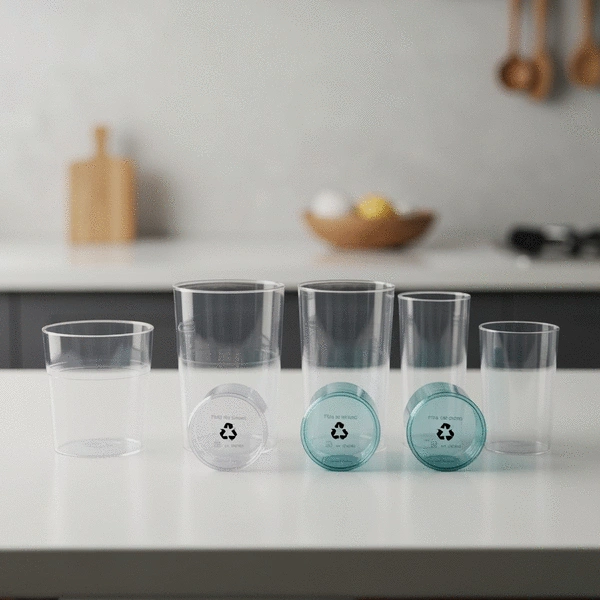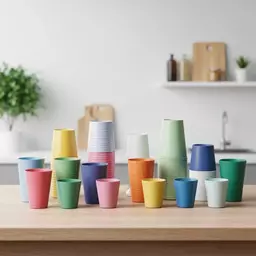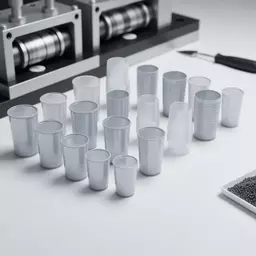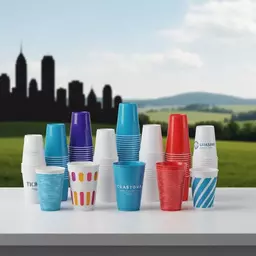Have you ever wondered what goes into choosing the right plastic cups for your business? The importance of food-grade plastic cups cannot be overstated, especially when it comes to ensuring the safety and satisfaction of your customers. Let’s explore the essential insights that will help you make informed decisions.
What You Will Learn
- Food-grade plastic cups are specifically designed for safe food contact, reducing health risks.
- Common materials for food-grade plastics include polypropylene (PP) and polyethylene (PE), each with unique properties.
- Understanding resin codes on plastic products helps identify their safety for food use.
- Certifications, such as FDA approval, are crucial indicators of safety and quality in food-grade plastic products.
- Regular chemical migration testing is essential to ensure harmful substances do not leach into food and beverages.
- Selecting low-toxicity plastics contributes to a safer environment for food consumption.
- Sustainable practices, such as opting for biodegradable options, help protect the environment while maintaining safety standards.
Key Aspects of Food-Grade Plastic Cups
Understanding what makes plastic cups safe for food contact is crucial. Below, we highlight the key materials, safety standards, and verification steps that ensure consumer safety and product compliance.
What are Food-Grade Plastics?
- Polypropylene (PP): Strength, heat resistance, for hot beverages.
- Polyethylene (PE): Lightweight, versatile, for cold drinks.
- Polystyrene (PS): Inexpensive, disposable, lower durability.
Materials engineered for safe food contact.
Key Safety Standards & Certifications
- FDA Approval: Confirms material safety for food contact.
- USDA Certification: For use with organic products.
- ISO Certification: International quality management standards.
- NSF Certification: Meets public health standards.
Ensuring compliance & consumer trust.
Verifying Resin Codes (Types of Plastics)
- 1 (PET): Single-use, generally safe.
- 2 (HDPE): Safe, impact resistant.
- 5 (PP): Safe for food and hot liquids.
- 3 (PVC), 6 (PS), 7 (Other): Potential risks, often not recommended for food.
Identifies plastic type and food safety.
Chemical Migration Testing & Toxicity
- Consumer Protection: Prevents harmful substance leaching.
- Low Toxicity: PP & PE are generally safe.
- Higher Risk: PVC may contain harmful additives.
Ensures no toxic chemicals leach into food.
Understanding Food-Grade Plastic Cups and Their Importance
When it comes to choosing the right plastic cups for your business, understanding food-grade plastic cups is essential. These cups are designed specifically for storing and serving food and beverages, ensuring both safety and quality. The term "food-grade" refers to materials that are safe for contact with food, meeting strict regulations to protect consumer health. At Plastic Cups Manufacturers, we prioritize these standards, ensuring our products not only meet but exceed industry expectations.
But why is it so crucial to focus on food-grade materials? Whether you're running a bustling café or planning an event, the safety of your customers should always come first. Food-grade plastic cups reduce the risk of chemical leaching and contamination, giving you peace of mind while serving your delicious offerings. Let’s delve deeper into what makes these cups so significant.
What Are Food-Grade Plastics?
Food-grade plastics are materials specifically engineered to be safe for food and drink applications. They are made from substances that do not pose any health risks when in contact with food. Common examples include polypropylene (PP) and polyethylene (PE), materials recognized for their durability and safety. At Plastic Cups Manufacturers, we offer a variety of options that cater to your needs, whether you're looking for disposable or reusable solutions.
- Polypropylene (PP): Known for its strength and heat resistance, ideal for hot beverages.
- Polyethylene (PE): Lightweight and versatile, suitable for cold drinks.
- Polystyrene (PS): Commonly used for inexpensive disposable cups but with lower durability.
Understanding these materials helps you make informed choices for your business. By selecting food-grade options, you’re not only complying with health regulations but also demonstrating your commitment to customer safety.
The Role of Food Safety Standards in Plastic Use
Food safety standards play a critical role in determining which plastics are deemed safe for consumer use. In the United States, the FDA (Food and Drug Administration) oversees the regulations that ensure plastic materials used in food applications meet strict safety guidelines. These standards help prevent foodborne illnesses and ensure that harmful chemicals do not migrate into food and beverages.
- Compliance with FDA guidelines: Ensures safety and quality in food contact materials.
- Regular testing: Manufacturers must conduct tests to confirm their products meet safety standards.
- Transparency: Consumers should have access to information regarding the safety of the plastics they use.
By adhering to these guidelines, Plastic Cups Manufacturers not only offers high-quality products but also builds a trustworthy relationship with clients. When you choose to work with us, you’re supporting a business committed to creating safer food environments.
Identifying Food-Grade Plastic Cups: Key Steps to Ensure Safety
Identifying food-grade plastic cups is vital to ensuring the safety of your products and customers. Knowing the key steps can save you from potential health risks and enhance your brand’s reputation. Let's explore how you can verify the safety of the plastic cups you choose.
Verifying Resin Codes: A Guide to Types of Plastics
One of the first steps in identifying food-grade plastics involves verifying the resin codes found on the bottom of plastic products. These codes indicate the type of plastic used and its safety for food contact. Understanding these codes is essential for making informed purchasing decisions. For a comprehensive guide on various food-grade and food-safe plastics, Acme Plastics provides detailed insights.
- 1 - Polyethylene Terephthalate (PET): Generally safe but designed for single-use.
- 2 - High-Density Polyethylene (HDPE): Considered safe and resistant to impact.
- 5 - Polypropylene (PP): Safe for food use, often used for hot liquids.
By familiarizing yourself with these codes, you can ensure you're selecting the safest options for your business. Our commitment at Plastic Cups Manufacturers is to provide you with clarity and quality, helping you find the right products every time.
Understanding the Seven Resin Codes and Their Implications
The seven resin codes are crucial for understanding plastic materials and their uses. Here’s a brief overview of each code:
- 1 (PET): Often used for clear bottles and containers.
- 2 (HDPE): Common in milk jugs, detergent bottles, and more.
- 3 (PVC): Typically not recommended for food use due to harmful additives.
- 4 (LDPE): Used in bags and some food wraps, generally safe.
- 5 (PP): Used in yogurt containers and straws, safe for food.
- 6 (PS): Commonly used for disposable cups, but can leach chemicals.
- 7 (Other): Includes various plastics, some of which may be unsafe.
Understanding these codes helps you navigate the plastic landscape and choose safer products. At Plastic Cups Manufacturers, we prioritize transparency, ensuring our clients have all the information needed for safe choices.
Checking for Certifications: What to Look For
When selecting food-grade plastic cups, certifications are a crucial aspect to consider. They provide assurance that the products meet established safety standards. Always look for specific certifications that indicate compliance with health regulations. For instance, Plascene offers valuable information on FDA-compliant plastics for food storage.
- FDA Approval: Confirms that the material is safe for food contact.
- USDA Certification: Relevant for cups used with organic products.
- ISO Certification: Indicates internationally recognized quality management standards.
At Plastic Cups Manufacturers, we ensure that our products are backed by necessary certifications, giving our clients the confidence they need when purchasing. Ensuring your cups are certified not only protects your customers but also enhances your brand’s credibility.
FDA Approval and Other Relevant Certifications
FDA approval is one of the most important labels to look for when choosing plastic cups. It signifies that the product has undergone rigorous testing and meets the required health and safety standards. Besides FDA approval, consider looking for:
- NSF Certification: Indicates that the product meets public health standards.
- CE Marking: Required for certain products sold in the European Economic Area.
These certifications play a vital role in maintaining trust with your customers. By offering products that are certified safe, you’re contributing to a more health-conscious industry.
Conducting Chemical Migration Testing: Importance and Process
Chemical migration testing is an essential process that determines whether harmful substances will leach from plastic into food and beverages. Understanding this process can guide you in selecting the right products and ensuring safety for consumers.
- Testing Methods: Various methods can be employed, including simulating real-life conditions.
- Frequency of Testing: Regular testing is crucial to ensure ongoing safety.
At Plastic Cups Manufacturers, we advocate for thorough testing of our products, ensuring they comply with safety regulations and providing peace of mind to our clients.
How Migration Testing Ensures Consumer Safety
Migration testing helps confirm that toxic chemicals are not leaching into consumables. This is a vital step in the manufacturing process, and here’s why it matters:
- Consumer Protection: It minimizes health risks associated with chemical exposure.
- Quality Assurance: It ensures high-quality products are delivered to consumers.
By conducting these tests, we at Plastic Cups Manufacturers demonstrate our commitment to safety, quality, and sustainability. This careful approach ensures that our clients can focus on what they do best—delighting their customers with safe, reliable products!
Understanding Toxicity Levels in Food-Grade Plastics
Understanding the toxicity levels in food-grade plastics is fundamental for ensuring consumer safety. Each type of plastic has different properties and potential risks associated with them. Here’s what you need to know:
- Low Toxicity Plastics: Plastics like polypropylene and polyethylene are generally recognized as safe.
- Higher Risk Plastics: Some plastics, such as polyvinyl chloride (PVC), may contain harmful additives.
By selecting cups made from low-toxicity materials, you can confidently serve your products knowing you’re safeguarding your customers’ health. At Plastic Cups Manufacturers, we prioritize using materials that reflect our commitment to both quality and sustainability.
Pro Tip
When selecting food-grade plastic cups, always inquire about the manufacturing process. Cups produced with less environmental impact not Preot only conserve resources but also reinforce your brand's commitment to sustainability. Opting for suppliers that prioritize eco-friendly practices can significantly enhance your brand’s image in the eyes of environmentally conscious consumers.
Summarizing Best Practices for Identifying Food-Grade Plastics
In the realm of food safety, understanding how to identify food-grade plastics is crucial for both manufacturers and consumers. At Plastic Cups Manufacturers, we emphasize the importance of knowing what makes a plastic cup safe for food contact. Here are some best practices to ensure the safety and compliance of the products you choose:
- Verify Resin Codes: Always check the resin codes on plastic cups to understand the type of plastic used.
- Look for Certifications: Ensure that the cups have necessary certifications such as FDA approval.
- Conduct Chemical Migration Testing: This testing helps confirm that harmful substances do not leach into food and beverages.
- Choose Reputable Suppliers: Partner with suppliers that prioritize safety and sustainability.
By following these guidelines, you can make informed choices that not only protect health but also reflect your commitment to sustainability in your events or businesses.
Key Takeaways on Ensuring Safety and Compliance
As we navigate the world of food-grade plastics, it’s important to remember a few key takeaways:
- Awareness of material properties and certifications is vital for ensuring food safety.
- Understanding the impact of additives and chemicals in plastics can help avoid harmful substances.
- Regular updates on regulations and compliance standards are essential for manufacturers and consumers alike.
By keeping these points in mind, we can create a safer environment for food consumption and promote healthier practices in our industry.
Encouraging Sustainable Practices in Food-Grade Plastic Use
At Plastic Cups Manufacturers, we are passionate about not just providing high-quality plastic products, but also promoting sustainability in their use. Here are some sustainable practices you can adopt:
- Opt for Biodegradable Options: Choose products that break down naturally, reducing environmental impact.
- Participate in Recycling Programs: Encourage recycling among consumers to minimize waste.
- Educate Customers: Share information on safe disposal and the importance of choosing food-grade materials.
By embracing these practices, you’re not just ensuring safety; you’re also contributing to the health of our planet. Together, we can make a difference!
Frequently Asked Questions about Food-Grade Plastic Cups
- What does "food-grade" mean for plastic cups?
- Food-grade refers to plastic materials that are safe for contact with food and beverages, meaning they will not leach harmful chemicals or contaminants into what you consume.
- Which types of plastic are generally considered food-grade?
- Common food-grade plastics include Polypropylene (PP), Polyethylene (PE), and Polyethylene Terephthalate (PET). These are often identified by resin codes #1, #2, and #5.
- Why are resin codes important when choosing plastic cups?
- Resin codes (the numbers inside the recycling triangle) identify the type of plastic. Codes #1, #2, and #5 are generally safe for food contact, while plastics with codes #3 (PVC), #6 (PS), and #7 (Other) may pose higher risks and are often not recommended for food.
- What certifications should I look for to ensure plastic cups are safe?
- Look for certifications such as FDA Approval, USDA Certification (for organic products), ISO Certification (for quality management), and NSF Certification (for public health standards). These indicate that the products meet rigorous safety guidelines.
- What is chemical migration testing and why is it important?
- Chemical migration testing determines if harmful substances will leach from plastic into food or beverages. It is crucial for consumer protection, minimizing health risks, and ensuring the quality and safety of plastic food contact materials.
Recap of Key Points
Here is a quick recap of the important points discussed in the article:
- Understand Food-Grade Plastics: Ensure that the materials used are safe for food contact, such as polypropylene (PP) and polyethylene (PE).
- Verify Resin Codes: Always check the resin codes on plastic cups to identify the type of plastic and its safety for food use.
- Check Certifications: Look for FDA approval and other relevant certifications to ensure safety and compliance with health standards.
- Conduct Chemical Migration Testing: This testing is crucial to confirm that harmful substances do not leach into food and beverages.
- Choose Reputable Suppliers: Partner with suppliers that prioritize safety, quality, and sustainability in their products.




